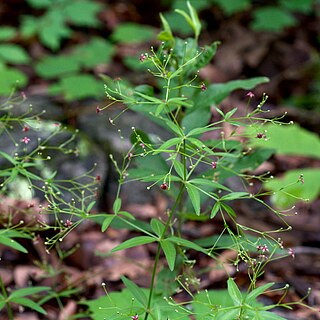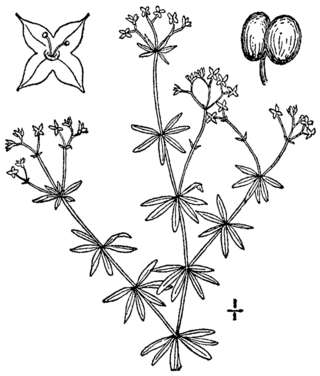
Viola canadensis is a flowering plant in the Violaceae family. It is commonly known as Canadian white violet, Canada violet, tall white violet, or white violet. It is widespread across much of Canada and the United States, from Alaska to Newfoundland, south as far as Georgia and Arizona. It is a perennial herb and the Latin specific epithet canadensis means of Canada.

Atriplex confertifolia, the shadscale or spiny saltbush, is a species of evergreen shrub in the family Amaranthaceae, which is native to the western United States and northern Mexico.

Quercus rugosa, commonly known as the netleaf oak, is a broad-leaved tree in the beech and oak family Fagaceae. It is native to southern North America.

Crusea is a genus of angiosperms in the family Rubiaceae. The genus is found in the south-western United States, Mexico, and Central America. A few species are naturalized in Cuba and Puerto Rico.
Hieracium carneum, common name Huachuca hawkweed, is a North American plant species in the family Asteraceae, native to Arizona, New Mexico, Texas and Chihuahua. It grows on rocky sites at elevations of 2,000–2,300 m (6,600–7,500 ft).
Allium perdulce, the Plains onion, is a plant species native to the central part of the United States and cultivated as an ornamental elsewhere. It has been found in Texas, New Mexico, Oklahoma, Kansas, Nebraska, South Dakota, and one county in western Iowa.

Bouvardia ternifolia, the firecracker bush, is a shrub widespread across much of Mexico, the range extending south into Honduras and north into the southwestern United States.

Galium arkansanum, the Arkansas bedstraw, is a plant species in the Rubiaceae. It is native to the Ozark and Ouachita Mountains of Missouri, Arkansas and Oklahoma in the United States.

Galium concinnum, the shining bedstraw, is a herbaceous perennial plant species in the Rubiaceae family. It is native to the Midwestern United States and central Canada, especially the Great Lakes Region and the Valleys of the Ohio, lower Missouri, and upper Mississippi Rivers. It is commonly found in deciduous forests and forest edges. It grows low to the ground in natural habitats. Although it is not an invasive species, it can be very weedy. It is typically not cultivated.

Galium mexicanum is a species of plant in the family Rubiaceae. It has a widespread distribution from British Columbia south to Ecuador.
Galium microphyllum is a species of plant in the family Rubiaceae. It is widespread across much of Mexico, and found also in Guatemala, Arizona, New Mexico and western Texas.
Galium orizabense is a species of plants in the family Rubiaceae, named for the town of Orizaba in Veracruz, where the first collections of the species were made. The species is native to Mexico, Costa Rica, Guatemala, Panamá, Venezuela, Colombia, and Hispaniola, plus widely scattered locations in the southeastern United States.

Galium pilosum, the hairy bedstraw, is a species of plants in the Rubiaceae. It is native to the southern and eastern United States and Canada from Texas to Florida north to Kansas, Michigan, Ontario, Quebec and New Hampshire. There are also isolated populations in Arizona, New Mexico, Colorado and Hispaniola. The plant is classified as a noxious weed in New York, Pennsylvania, Massachusetts and Connecticut.

Galium tinctorium, the stiff marsh bedstraw, is a species of plants in the Rubiaceae. It is widespread and common across the eastern part of North America, from Texas to Labrador and from Minnesota to Florida, plus eastern and central Mexico and the Dominican Republic. It is classed as a noxious weed in some parts of the northeastern United States.
Galium uncinulatum, common name bristly bedstraw, is a species of plants in the Rubiaceae. It is native to Mexico, Guatemala, Costa Rica, Panama, Texas, and Arizona.

Galium virgatum, common name southwestern bedstraw, is a North American species of plants in the Rubiaceae. It is native to the south-central part of the United States, primarily in the southern Great Plains from Texas to Missouri, but with scattered populations as far east as South Carolina.

Galium wrightii, common name Wright's bedstraw, is a species of plants in the Rubiaceae. It is native to northwestern Mexico and southwestern United States: Sonora, Chihuahua, Arizona, New Mexico, western Texas, southwestern Utah, southern Nevada and southeastern California In California, this plant is ranked as rare, threatened, or endangered in CA; common elsewhere.

Machaeranthera asteroides, the fall tansyaster, is a North American species of plants in the sunflower family. It is native to the southwestern United States and northern Mexico.
Heterotheca fulcrata, known by the common name rockyscree false goldenaster, is a North American species of flowering plant in the family Asteraceae. It has been found in northern Mexico and in the western United States.
Heterotheca viscida, called the cliff goldenaster, is a North American species of flowering plant in the family Asteraceae. It grows on cliffs and ledges in mountainous regions. It grows in the southwestern United States, primarily in Arizona, New Mexico and southern Texas with reports of isolated populations in Nevada, southeastern Idaho, and southeastern Colorado.













